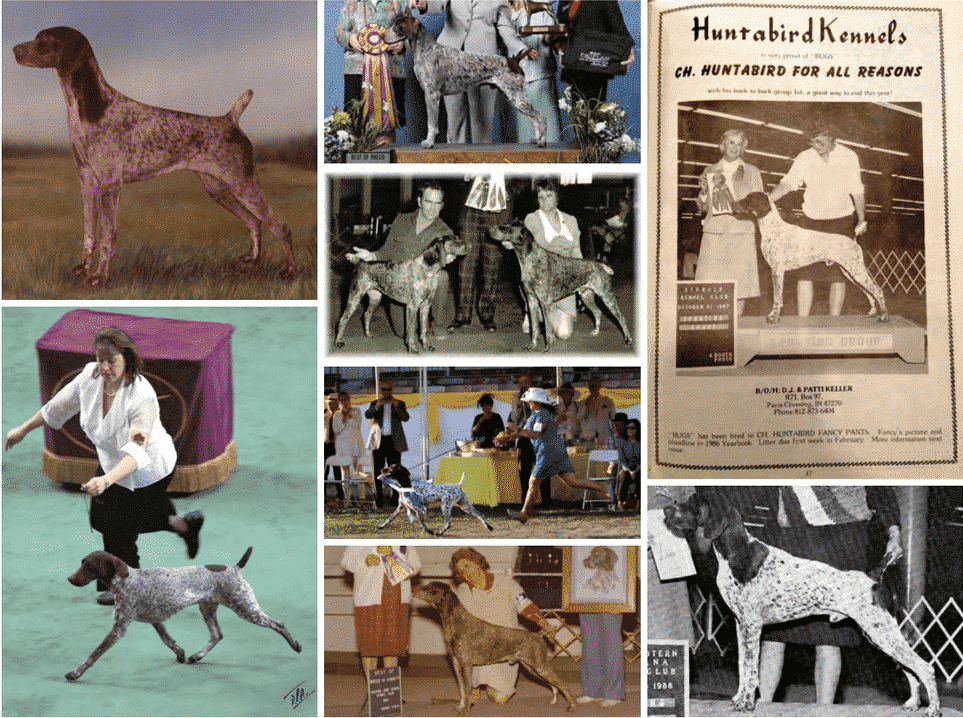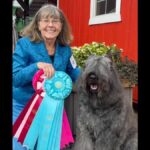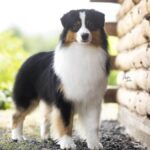To convey to judges and dog fanciers the “Hallmarks” of the German Shorthaired Pointer (GSP), over 40 German Shorthaired Pointer Club of America breed mentors, breeders, and judges were asked to share their thoughts on a few questions. Respondents had from 25 years to over 50 years of experience in the breed. In their responses to the questions, a theme emerged: These breed experts would like judges and breeders to be reminded that, as with other breeds, the German Shorthaired Pointer Hallmarks are unique and that clearly identify it as a GSP versus a Weimaraner, versus a Vizsla, versus a Pointer. These short-coated Sporting breeds do have traits in common; however, they are very different breeds and should be judged as such. Silhouettes of these four breeds are included here to help demonstrate the breed differences.



Please enjoy the sum of the observations from the GSPCA breed experts who were polled:
1) How would you describe Hallmarks of the German Shorthaired Pointer breed to a judge?
- A medium-sized, aristocratic, balanced dog with a head proportionate to the body, showing strength and depth, and with compact, round, tight feet. Balanced, smooth reach; with strong drive to cover plenty of ground with little effort.
- Judges should be focusing on sound structure and a balanced, typey silhouette—first and foremost, the whole picture; proved by a ground-covering, fluid trot.
- The GSP is a short-backed dog that should be more square than long.
- An aristocratic and athletic dog that is intelligent, with an expression reflecting intelligence and kindness.
- A GSP is medium in size, square or slightly off-square in outline, with a docked tail, and a short, thick coat that is liver or liver and white in color.
- The most obvious would be the colors (liver or liver and white) and a short, hard or “tough to the touch” coat. Those who developed the GSP at some point must have decided that liver (or liver and white) was one of the Hallmarks that set the breed apart visually from the other “chicken dogs” being used in Germany. They eliminated all other colors through selective breeding. They also understood that a tough coat would shed water, dirt, and briars.
- Although GSPs are not considered a “Head Breed,” the heads are distinct from other gundogs. The head should be clean cut and in proportion to the dog’s body. The eyes should be almond-shaped and never round, and the definitive eyebrow should give the dog a pleasing, intelligent, and very approachable expression. There should never be a pronounced stop as in the (English) Pointer, but a gradual rise—never a stop. The rise is somewhat more pronounced in dogs than in the bitches. The ear set should be slightly above the eye level. The length of ear and the way it lies should never give the impression of a hound-like appearance, and it should enhance the expression. The muzzle should be deep and have a sufficient underjaw to enable the dog to perform in water and on land when carrying a bird as large as a goose, pheasant or chukar.
- Capable, functional, intelligent, all-purpose gundog. Short-backed, aristocratic, regal. Giving the impression, immediately, that they can do the job that they were bred to do. Dark almond eyes, proper angulation to allow the smooth, effortless movement. SOUND movement. This is supposed to be a multi-functional breed; they need to be able to move soundly and effortlessly. Sound, solid temperament.
- In my opinion, the primary Hallmark of the GSP is its coat texture. Others that I consider Hallmarks: Nose large, broad; nostrils well open (double barrel shotgun) and, viewed in profile, the tip (rhinarium) slopes slightly downward. (This is not a Roman nose, which would begin in the bone structure prior to the nose leather.) Feet are tight, with strong nails and thick/hard pads.
- Overall symmetry and power. A sturdily-built, medium-sized hunting dog with strong, balanced angulation to cover ground without wasted effort.

From a Breeder’s Perspective:
2a) What should judges be rewarding in the show ring?
- A MEDIUM-sized, balanced dog that moves smoothly with balanced reach and drive. Although not a “head breed,” the proportion and strength of the head is very important for function. Tight, compact, round feet.
- Judges should be focusing on sound structure and a balanced, typey silhouette—first and foremost, the whole picture; proved by a ground-covering fluid trot.
- Sound, solid movement, solid temperament, and correct structure that includes proper angles and strong, solid toplines. Proper front and rear angles. Regal in appearance.
- Judges should be rewarding dogs that are sturdily built to do a full day’s hunting; those with the balance and symmetry
to move effortlessly. This comes from an evenly-matched sloping front and well-turned rear, with a strong back to
support both. Also, rib spring and rib depth are needed
for endurance.
2b) What are the judges missing when judging this breed?
- Besides the need for correct angulation, forechest, depth of chest, and movement, judges are missing that the best dog might be the one that DOES NOT look like all the others in color, size, and/or shape. Inferior dogs might be in the majority at a show, but rewarding them in favor of “consistency in judging” is not in the best interest of the breed.
- There are nuances of each of the breeds that are specific to each. They are not interchangeable, with just a different coat color. Also, they are missing the round eyes, poor conditioning, slab-sidedness and [incorrect] type. Type in a GSP is dramatically different from an (English) Pointer, Vizsla
or Weimaraner.
- MEDIUM SIZE, proper balanced movement, correct head type with strong UNDERJAW, compact tight feet. Too many mediocre, generic dogs instead of aristocratic.
- An aristocratic, balanced-moving dog with a beautiful head (including a correct underjaw) and tight, compact, round/spoon feet.
- Too many judges are rewarding extreme side gait; over-reaching fronts due to over-angulated rears. Dogs that are long and low. They misunderstand “with a short back, standing over plenty of ground.” Please reward bitches that are the correct size of 21 to 23 inches.
- Proper shoulder layback with good length of upper arm, which allows for reach. A flashy mover may not be as correct as an easy-going, efficient mover that would function well in the field. A dog with a longer back may be flashy in side gait, but is not clean on the down and back.
- Many judges IMO are willing to put up dogs above standard height, which is to be severely faulted. We are also witnessing ponderous dogs being awarded that could never hold up long-term in the field. Many also judge more on the stack than on movement. While hunting, GSPs are expected to hold a point for long periods of time; however, the majority of their time in the field is [spent] moving. An oversized, unbalanced dog has a much harder time of being able to hunt all day long, let alone for most of its life.
- Dogs/bitches a lot longer than tall. When this was added to the standard in 1992, dogs/bitches were measured, and longer than tall was considered to be 5 percent, but not longer than 10 percent longer than height at the withers… described as “slightly off square.” Thus, if a dog is 23 inches at the withers, to be considered slightly longer than tall (measuring from the forechest to the rearmost projection of the rump), the length per the standard would be 25.3 inches long at the max of 10 percent, and 24.2 if using the minimum of 5 percent.
2c) What would you like to see judges reward in the
show ring?
- The Standard, correct movement, soundness, and type.
- An aristocratic, balanced-moving dog with a beautiful head (including a correct underjaw) and tight, compact, round/spoon feet.
- Dogs and bitches that are the correct size, clean and efficient movement, and dogs that are more square than long.
- A good, honest Shorthair that is correct to the standard in all areas. These dogs/bitches are often overlooked because they aren’t flashy.
- Correct angulation (sloping shoulders and strong rears) should be rewarded. Equally straight front and rear angulation may have symmetry, but they do not provide the powerful, ground-covering gait needed for high-performance as a hunting dog. The proper front and the depth of chest needed for endurance. Correctly carried tails, without excessive curl, should also be rewarded.
- I would love to see judges who have a good understanding of what GSPs are expected to do in the field. Always awarding good breeding stock, keeping type, balance, movement, and size in mind, not just a “showman” or a well-presented dog.ž

Please judge our dogs on the move. When in doubt, move them again!
In summary, when judging our breed, please envision the distinct Hallmarks of the German Shorthaired Pointer are:
The German Shorthaired Pointer is a versatile hunter—an all-purpose gun dog capable of high performance in field and water, which should be reflected in the show ring. The GSP should give the impression of an aristocratic, well balanced, symmetrical animal with conformation indicating power, endurance and agility with a look of intelligence and animation. The GSP is a “short backed” hunter standing over plenty of ground.
GSPs are a medium-sized, square or “slightly” longer than tall dog. It is interesting to note that the “or slightly longer than” was added to the standard in the ‘90s. Symmetry and field quality are most essential in this breed. A dog in field condition is not to be penalized; however, overly fat or poorly muscled dogs are to be penalized. A dog that is well-balanced in all points is preferable to one with outstanding good qualities and defects. Grace of outline, clean-cut head, sloping shoulders, deep chest, powerful back, strong quarters, good bone composition, adequate muscle, well-carried tail, and taut coat produce the look of nobility and indicate a heritage of purposefully conducted breeding. Further evidence of this heritage is movement, which is balanced, alertly coordinated, and without wasted motion.
The Hallmarks of the German Shorthaired Pointer
Thank you to all the breed mentors, breeders, and judges who contributed to this article.













